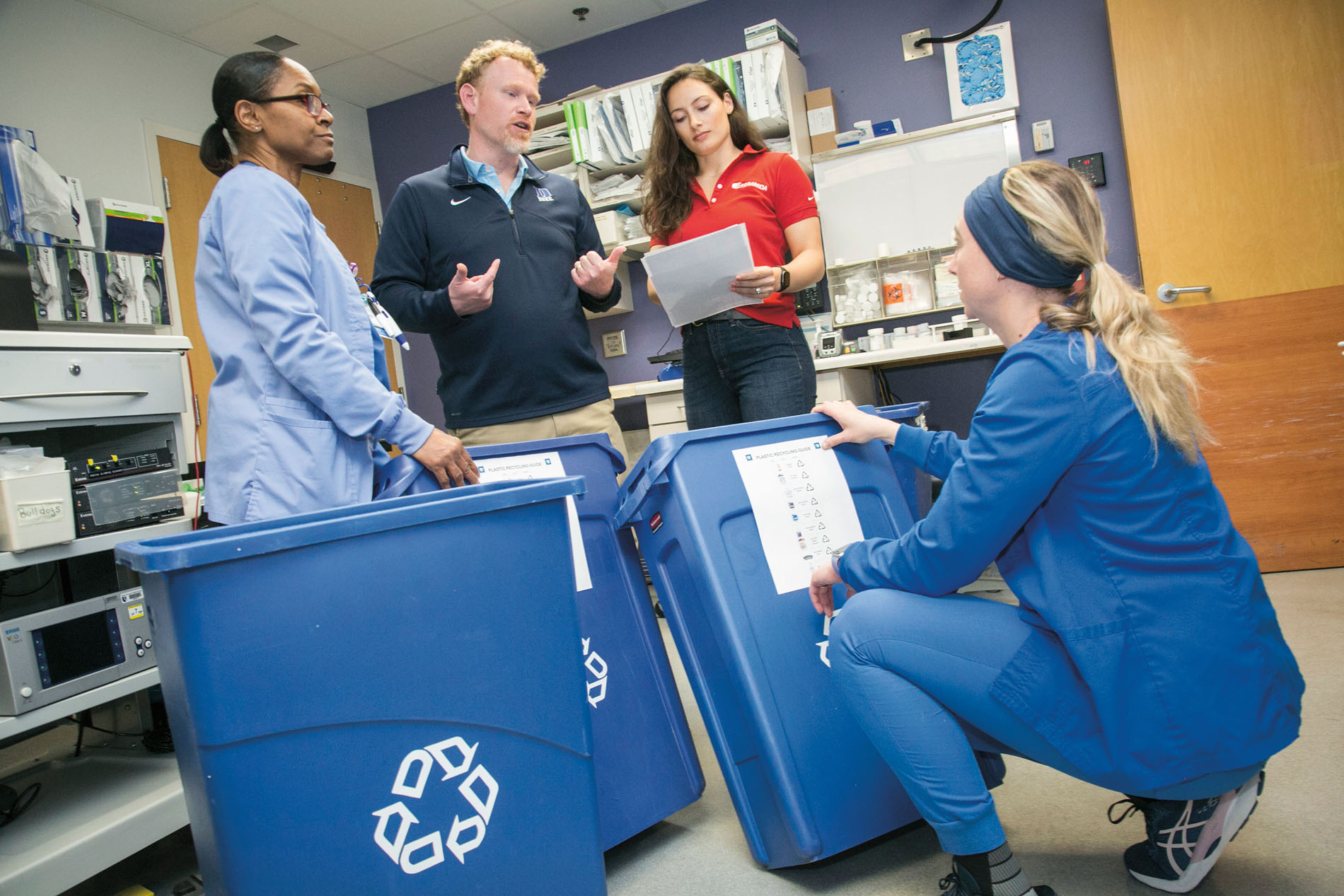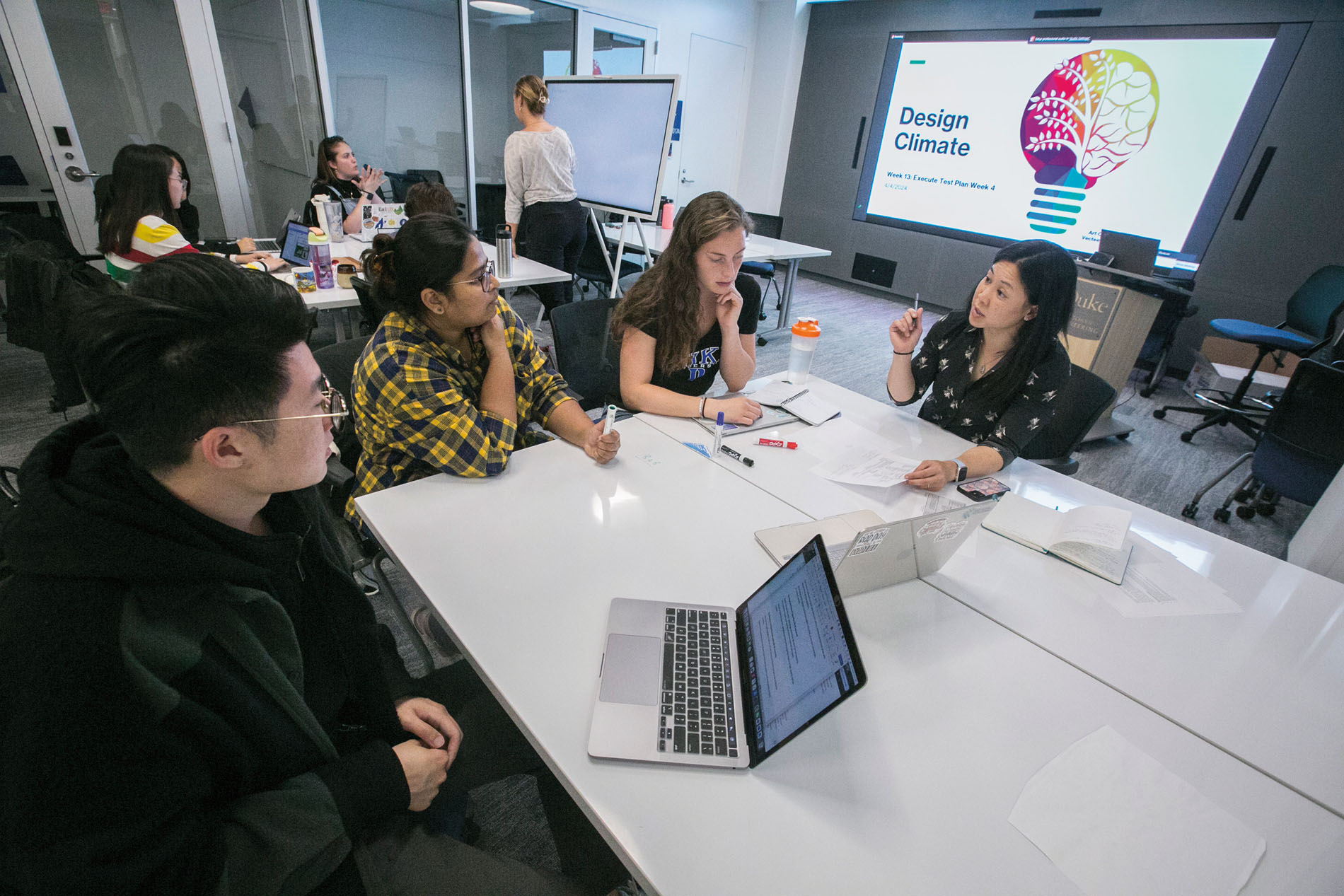On a Thursday morning in March, 13 students in Duke’s Design Climate course practice their pitches for sustainable business ideas. Instructors give them feedback like it’s a kinder, gentler “Shark Tank.”
Don’t make the pitch too long. Don’t talk like a scientist. Capture the investor’s attention. Appeal to their bottom line. Master of engineering management student Muskan Jindal raises her hand. She looks concerned. Sustainable packaging – her group’s product – is good for the planet. Shouldn’t social responsibility be enough?
“How do you make people care about something they don’t care about?” Jindal asks.
Here in Wilkinson, in a glass-walled classroom with exposed pipes and vents for a ceiling, students also try to strike a balance between glossy presentation and practical functionality. In Design Climate, a sustainable business idea is not enough on its own. Judy Ledlee M.S.’15, Ph.D.’17, executive director of Design Climate, and fellow instructors Alexis Carpenter and Kat Horvath challenge students to not only develop a morally sound business idea, but to sell it as well. Each student team’s business is a vehicle for an environmental mission and must fulfill the triple bottom-line framework of profit, people and planet.
In Design Climate, tomorrow’s green engineers and entrepreneurs get the thing there is no substitute for: experience.
“Most people care about sustainability, but this is a business,” Ledlee tells her class.
Ledlee had her first entrepreneurial experience as a Duke student, as part of a team that won the 2013 Duke StartUp Challenge in the clean energy track. After graduation, she continued in the green technology field, working for three companies before returning to lead Design Climate. She teaches with grounded pragmatism.
“You’ll never be penalized for something that makes sense,” she tells her students.
This is the course Ledlee’s co-instructors wish they could have taken. Horvath, who always excelled in math and science, went into engineering as a safe bet. It’s where the jobs are. In the real world, though, theoretical classes didn’t prepare her for complex problems with human elements such as logistics or communication. Reading an audience and meeting people where they are is part of the real-world engineering experience.
“Everyone's going to make decisions off of something different,” Horvath says. She hopes the class can make students “savvy enough to tailor your argument to the person that you're talking to – whatever audience you're talking to.”
Three teams make up the course. Two are marketplaces – one for sustainable packaging and one for solar panel recycling – and one is a business that deals in wetland carbon offsets. The Thursday after the teams practiced their pitches, the carbon offsets group presents what it has learned. Alayna Burns, a senior majoring in economics with a minor in environmental science and a sustainability engagement certificate on the side, is visibly excited. Their business idea has a potentially viable customer base in universities, she explains, which can use participation as positive PR.
“You just defined willingness to pay,” Carpenter says.
The best outcome, says Horvath, would be if Design Climate students can commercialize their work – just as Ledlee did when she was in their position. For Jindal, who wasn’t interested in sustainability when she started graduate school, the course has already changed her trajectory. Now, she says, she will be leading a sustainable supply chain initiative at auto parts manufacturer Tenneco. Indeed, what happens in this room in Wilkinson may have impacts well beyond Duke.
“Signing an IP agreement at the beginning of the class was so cool,” says Burns. “I was bragging about it to my dad. I'm signing this IP agreement. There's a chance I do something that has value.”

Climate Fluency for Duke Health Professions
John Lohnes kneels on a Duke Health warehouse floor in west Durham and unwraps a blue package. He opens a large black garbage bag, then another. Single-use laryngoscopes. Gauze. Diapers. Butterfly needles. Catheters. Surgical scissors. A set of infant defibrillator pads.
Everything here is unused. Most of it is unopened. Some of it was pulled for surgery or other procedures, then not needed. Some is simply surplus. Then, Lohnes, School of Nursing associate professor AnnMarie Walton and graduate student Tenley Weil get to sorting, turning medical surplus that would otherwise go to waste into donatable supplies.
“This is not a topic that’s typically covered,” Lohnes says.
Lohnes M.E.M ’82, B.H.S.’86, M.H.S.’91is a retired orthopedic physician assistant who practiced at Duke for more than 30 years and continues to volunteer. For the past 20 years, he has spearheaded REMEDY, the volunteer-run program that sorts and distributes usable Duke Health surplus to areas of need regionally and worldwide. Lohnes and Walton are two of 10 instructors in the newly piloted Introduction to Climate and Health for Health Care Professionals course, which is open to any health care student, regardless of field. Weil, who is in the Nicholas School of the Environment’s Integrated Toxicology and Environmental Health Program, takes the course alongside tomorrow’s doctors, nurses, PAs, occupational therapists and physical therapists.
According to the American Medical Association, the American medical sector is the second largest industrial contributor of landfill waste and a major greenhouse gas emitter. At the same time, climate change exacerbates some health problems and causes others, as the instructors illustrate with example after example.
Walton and co-lead Brian McAdoo ’91, a professor of earth and climate sciences, initially planned to introduce a dozen students to the climate cost of health care and the human cost of climate change. Forty signed up.
“This is a non-credit course,” Walton says. “This is something that students are asking to do on top of their already busy schedules.”
Climate Fluency for Duke Health Professions Students and Faculty is an asynchronous, virtual course grounded by get-togethers like the warehouse session. Climate change may seem abstract, but health care is about solving immediate, tangible problems, Lohnes says.
“It’s very direct,” he says.
When Walton came to the School of Nursing in 2017, she realized there was no climate change component to the population health and global society course, a core class for master’s students. Since her upbringing in a small, crowded New York City apartment, Walton has spent her entire life conscious of reuse and of sharing space. Her nursing perspective – a balance of lived experience and practical morality – drives Climate and Health.
“Nursing has a lot of its origins in places that other people didn't want to be – in inner cities, in places of poverty and in places where people have unmet needs,” Walton says. “Nurses have organized around environmental health issues for quite some time.”
For co-instructor Trisha Dalapati, an M.D./Ph.D. student, environmental health issues are as tangible as her family. Relatives in Kolkata caught tropical diseases like dengue and malaria and faced stigma, even after they were cured. She’s alarmed by these diseases moving into other regions thanks to a warming climate.
Dalapati and McAdoo created several podcast episodes for Climate and Health, digging into causes and impacts of climate disruptions. Dalapati asked environmental scientists questions from a medical perspective, while McAdoo asked medical professionals environmental questions.
“Each episode ends with something hopeful,” says Dalapati.
That sense of active hope, which is structural to Climate and Health, resonates with Weil. Before enrolling at Duke, she had a research career with the National Institute of Mental Health. Weil has long been driven to work in climate change – a critically important topic that seemed too huge, too sprawling to impact directly for much of her life. Now she sees what she can do.
In the Duke Health warehouse, Weil marvels at the variety of stuff – so much of it single-use plastic – the team sorted during the REMEDY session. Walton is suddenly focused. Health care workers can use their purchasing power to advocate for suppliers that use less plastic packaging, she says. Walton knows how busy nurses and doctors and their medical colleagues are. She also thinks these health and climate lessons, if taught right, can become second nature. “My desire as a scientist is to have medical professionals be aware of these connections, to have the idea in the back of their head and pause for a second,” says McAdoo.

Making Campus Recycling Matter
In Jeremy Pare’s two years as a visiting professor of business and environment at the Nicholas Institute for Energy, Environment & Sustainability, Duke has been his living laboratory of plastic recycling. The most common plastic items recycled on campus are No. 1: soda bottles and No. 2: milk jugs. He believes more can be done and that it can have an actual, tangible impact.
Pare doesn’t just put out more recycling bins, though. He builds behaviors. His goal is for people to actually want to recycle.
Pare likes to focus on increasing recycling rates in hospitals, and at Duke he chose an especially challenging setting. Clinic 2H, a gastrointestinal clinic with a prodigious output of not-so-sterile plastic waste, had no recycling whatsoever when Pare came to Duke. He introduced recycling of three types of plastic to the clinic.
“We started with GI, so we were watching colonoscopies and endoscopies,” says Pare. “One student actually passed out the first day we were there.”

Pare and his students weren’t even in scrubs. They were outsiders in the clinic, says Nicole Peck D.E.L.-M.E.M.’23, who worked under Pare’s wing on her master’s project. Pare’s team found common ground with the nurses who would be adding recycling to their already busy days. After a few days, the nurses started to enjoy asking the team whether whatever arcane medical plastic they were holding was recyclable.
The final piece of building recycling behaviors: Showing what all that plastic can be instead of trash. Recycled plastic can become shaving razors or toothbrushes. The recyclers that 2H uses, for instance, send the material to become plastic decking.
“When we impart that knowledge to the nurses and the people doing this work, they get so Jonesed up that they want to recycle more,” says Pare.
